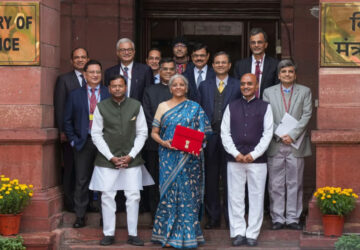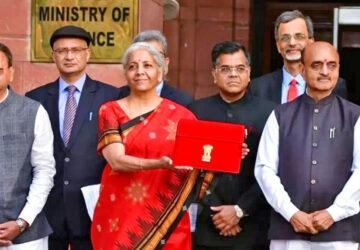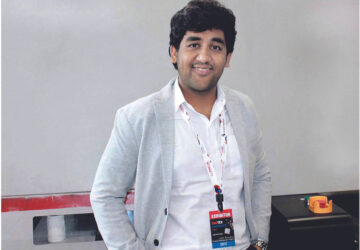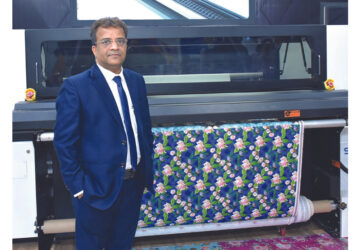To know more about the company and its future plans, Apparel Views Editor Arvind Kumar, interviewed Balkrishan Sharma – Business Head and Chief Executive – Yarn, RSWM limited. Some excerpts from the same is shared here.
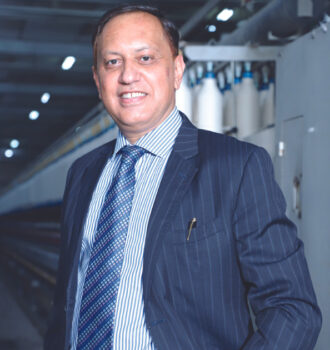 Tell us about your company in term of infrastructure, production capacity and future plans. What is the share of domestic and export?
Tell us about your company in term of infrastructure, production capacity and future plans. What is the share of domestic and export?
The LNJ Bhilwara Group’s flagship company, RSWM Limited, established in 1960, is one of India’s leading textile manufacturers and exporters and has a global reach to more than 78 nation’s worldwide as well as strong PAN India penetration. RSWM is a manufacturer of high quality of Dyed, Grey, Mélange yarns, denim and knitted fabrics. The spindle capacity of RSWM exceeds 5 lacs and has 5120 rotors, 172 looms and 56 knitting machines. In totality, we produce 1,50,000 metric tons of yarns, 32 million meters of denim fabrics and 5400 metric tons of knitted fabrics annually.
RSWM Limited is poised to expand its horizons in the coming years through a series of strategic investments and capacity enhancements. As already explained, our growth trajectory is underpinned by a substantial investment of Rs. 315 cr, which has facilitated the introduction of 51,072 premium compact cotton yarn spindles under the brand name KAPAAS which combines technological prowess of Trützschler Group, Marzoli Central Asia, KTTM, Rieter and a centralized quality control system by Uster Technologies under one roof. This expansion is not just a measure of our growth but a testament to our commitment to excellence, which we anticipate will significantly amplify our turnover and profitability in the near future. In the current year, share of domestic market has increased to 74% for grey and dyed yarns and 79 percent in melange yarns. This share historically has been 50:50.
What are the different product ranges you are manufacturing, and new products launched recently?
In Yarns, RSWM boasts a comprehensive yarn portfolio in Ring Spun, Open end, Compact, Eli-Twist, TFO and Industrial Yarns. RSWM yarns are used in wide range of textile and industrial segments of knitting, weaving, home textiles, denim, carpet, sewing threads, industrial hoses, canvas, narrow tapes, technical textiles, embroidery, lamination/shoe upper, protective clothing and medical end use to name a few.
We offer ring spun yarns in various counts with polyester, acrylic, cotton, viscose, and their blends. Additionally, we provide specialized options with features like super high tenacity and biodegradability in polyester spun segment. RSWM’s premium brands include ULTIMA in Polyester and Polyester/viscose blends and KAPAAS in cotton compact yarns. Dyed, value-added yarns, and sustainable choices like organic cotton and recycled polyester along with special effects and functional yarns further expand our offerings.
The LNJ knit division offers a dynamic product range comprising knitted fabrics like Single Jersey, Interlock, Rib, Fleece, Flat Back Rib, Terry, Foma, Honey Comb, Pique, Waffle, and others. In addition, we provide our consumers with quality denim fabric, using the latest methods and technologies.
With the development of biodegradable recycled polyester driven by CiCLO technology, RSWM is leading the way in the sustainable textile revolution when it comes to newly introduced products. Furthermore, our technical team is pushing the envelope of innovation to create textile mixes that keep our commitment to environmental responsibility while still competing with conventional counterparts in terms of quality and cost.
What sustainable initiatives you have taken both in terms of manufacturing and product offerings?
The global shift toward sustainability significantly influences yarn preferences as consumers increasingly prioritize eco-friendly choices. For RSWM Limited sustainability is the very fabric of our operations. RSWM demonstrates its commitment to sustainable practices through adherence to international standards like the Global Organic Textile Standard (GOTS), Regenagri and the Better Cotton Initiative (BCI), ensuring ethical and environmentally responsible products.
We are aware of the challenges of waste management and chemical hazards and it is in this backdrop that our commitment to eco-conscious practices shines through. RSWM continually seeks ways to minimize waste, use renewable materials, and reduce energy consumption in its operations. We offer fabrics dyed with environmentally friendly dyes and pigments and employs advanced techniques that minimize water and chemical usage.
To address water conservation, RSWM treats all post-process water in its effluent treatment plant and further purifies it via reverse osmosis before returning it to the environment in a cleaner state. Achieving zero liquid discharge, RSWM saves 1350 kilolitres of water daily.
Notably, RSWM was the first company in Rajasthan to establish a PET recycling plant in Ringus, recycling over 60 lacs discarded plastic bottles daily (equivalent to 2190 million bottles annually that would have otherwise ended in landfills). These bottles are transformed into innovative, eco-friendly fibres under the brand name “Fibre Green,” subsequently used in yarn production. RSWM’s commitment to sustainability extends beyond words, setting industry standards for others to follow.
RSWM also actively recycles pre and post-consumer waste, processing 30 tons of worn fabric monthly through garneting. RSWM demonstrates its commitment to clean energy with a total of 32.36 MW of solar power plants installed on rooftops and ground mounts, complemented by a 40 MW wind capacity. RSWM annually reduces CO2 emissions by an impressive 39974718 lbs from solar power alone.
So, in nutshell, the green revolution in textiles presents a golden opportunity for RSWM. Our robust sustainability initiatives resonate with the growing demand for environmentally friendly textiles, placing us at the forefront of this transformative era. This synergy of values and market trends positions RSWM as a leader in the sustainable textile frontier.
What is the present trend in fabric as per the demand by garment manufactures?
The current trends in fabric as demanded by garment manufacturers are showing a clear move towards sustainability and innovation. One significant trend is the increasing use of natural fibres such as cotton, silk, linen, wool, and cashmere, with production rates for these materials on the rise due to their lesser environmental impact. This shift reflects a broader industry focus on sustainable production practices. For instance, the sustainable fabrics market was valued at USD 45.8 billion in 2022 and is expected to grow substantially, driven by rising awareness among fabric manufacturers about sustainable production.
The concept of “back-to-work fits,” which refers to clothing suitable for returning to professional environments, is also gaining traction, suggesting a demand for fabrics that cater to this need. Furthermore, there’s a move towards manufacturers that are geographically closer to the consumers, which could influence the types of fabrics in demand based on regional preferences.
Interior fabric trends also show a preference for materials that create a connection with the outdoors, such as wood, rattan, stone, cork, and natural fabrics, suggesting that garment manufacturers may also be considering these materials to appeal to consumers seeking a more natural, calming aesthetic.
Lastly, the global fabric market is also experiencing a rise in the demand for smart textiles, which incorporate advancements in fabric technology, and a shift towards digital printing. These trends are indicative of an industry that is being shaped by both the influence of fashion and design trends and the push for technological innovation.
Also, Sportswear and athleisure wear have been experiencing rapid growth, outpacing the fashion wear segment in recent times. In India, there is a noticeable gap in the market due to the limited availability of high-quality suppliers in these categories. Recognizing this opportunity, RSWM is strategically focusing its efforts on becoming a prominent manufacturer of fabrics tailored for international brands in sportswear, athleisure wear, as well as the fashion industry.
RSWM’s goal is to establish itself as a leading player in the production of textiles that cater to the diverse needs of these thriving sectors. The demand for such fabrics is not only driven by the domestic market but also by key export destinations such as Sri Lanka, Bangladesh, and Vietnam. This strategic direction underscores RSWM’s commitment to meeting the evolving demands of the global apparel industry and contributing to its growth by bridging the supply-demand gap in high quality sportswear and athleisure wear fabrics.
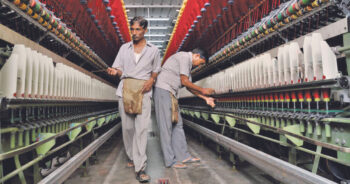 Where do you think Industry is lacking? What do you think industry should do to be more competitive, globally?
Where do you think Industry is lacking? What do you think industry should do to be more competitive, globally?
I would say that Indian textile industry, to remain competitive globally, should focus on operational efficiencies and cutting down costs, which can only be achieved by innovation and modernisation. This is the area, where we are lagging. You can’t do today’s job with yesterday’s methods and be in business tomorrow. Innovation and technology are the keys to unlocking the full potential of the Indian textile and apparel industry and it is high time that industry upgrades its game, which has been grappling with outdated technology and infrastructure, thereby leading to reduced efficiency, competitiveness, decrease in productivity, quality and consistency, lower value-addition and higher cost of production.
Industry must understand the Power of Digital Trade, which is another key element. The digital age isn’t just about smart phones and laptops but about smart textiles too. By embracing digital trade, Indian textiles can expand their market reach beyond their traditional boundaries and tap into new customer segments and geographies. They can also access real-time data and gain insights on customer behaviour, preferences and feedback, which can help them to tailor their products and services to better meet their customers’ needs. Embracing Industry 4.0, AI, ML and digitalisation will also allow them to streamline their operations, optimise costs and create a more agile and responsive supply chain.
Another important aspect is the Role of Forecasting Fashion. If fashion is a language, the Indian textile and apparel industry needs to become fluent in ‘trend- speak’. Fashion is a dynamic and influential industry that drives consumption and perceptions. By tracking and analysing fashion trends, the industry can anticipate the needs and wants of the global market of textile and apparel and adapt designs, colours, textures and finishes accordingly. This can lead to better quality, value and differentiation of the Indian textile and apparel industry as well as help build a stronger brand image while improving customer loyalty.
Building a better workforce is another crucial element. A skilled workforce is the backbone of any successful industry. The Indian textile and apparel sector has faced challenges related to workforce. The industry primarily relies on manual labour and requires skilled workers to meet global quality standards. Here we need to implement skill development programmes and undertake vocational training and partnerships with educational institutions to bridge the skill gap. This, if done, will not only improve the industry’s competitiveness but also create better job opportunities and uplift the socio-economic conditions of millions of workers. Initiatives like Pradhan Mantri Kaushal Vikas Yojana and National Skill Development Corporation are the right steps in this direction.
Niche markets may be small, but they do pack a big punch. This is another important consideration which industry must have in the backdrop of the fact that the global textile and apparel market is becoming increasingly diverse and specialised with consumers seeking unique, high-quality and customised products. However, the Indian textile industry has always predominantly focused on the mass production. By targeting niche markets such as organic textiles, luxury products, technical textiles and ethnic wear, Indian manufacturers can tap into new customer segments and create a distinct brand identity. This strategy will also enable them to charge premium prices, for higher profit margins and revenue.
In addition to the aforementioned points, it is imperative to prioritize the development of a robust capacity in the apparel industry, with a particular emphasis on man-made fibres. This strategic focus is underscored by the fact that a substantial 59% of global trade is centred around the apparel sector, and within this, a significant 52% pertains to man-made fibres.
Furthermore, it is essential for the industry to capitalize on the Free Trade Agreements (FTAs) that have already been negotiated and signed. Leveraging these agreements can create favourable conditions for international trade and enhance the sector’s competitive edge.
To achieve manufacturing excellence, fostering a culture of quality, strong compliance and embracing sustainable practices is paramount. This entails a commitment to consistently delivering high-quality products and services while simultaneously minimizing the environmental footprint. Such an approach not only ensures longterm success but also aligns with contemporary global trends emphasizing sustainability and responsible business practices.
How was the year 2022-23 for you as well as for the Indian weaving industry? How do you look forward to the year 2024?
The year 2022-23 was a period of endurance and learning for the Indian textile industry. First and foremost, the COVID-19 pandemic has exerted a lasting impact on the yarn market. This global health crisis disrupted supply chains, manufacturing processes, and consumer behaviour in unprecedented ways. The ensuing fluctuations in demand, coupled with disruptions in production and distribution, have introduced a high degree of uncertainty into the industry.
Compounding these challenges are the current geopolitical circumstances, marked by the outbreak of two wars and a worldwide economic downturn. These events have contributed to a heightened level of global instability, affecting trade relationships and demand contraction. High imports of knitted fabrics from Bangladesh and China is also making the matter worse especially for clusters like Ludhiana and Tirupur. As a result, yarn market participants must navigate a shifting and uncertain global trading environment.
Additionally, the market is contending with the spectre of soaring inflation, which is impacting the cost structure of yarn production. The industry is grappling with rising labour and energy costs, which further challenge its operational efficiency and competitiveness. As wages increase and energy prices surge, yarn manufacturers must implement effective cost management strategies to mitigate these cost pressures. All in all, these factors have placed considerable strain on the profitability of yarn manufacturers and distributors. The negative implications of these factors also affected the performance of RSWM Ltd. in 2022-23 to some extent. However, going forward, RSWM Limited is addressing these challenges in a professional and strategic manner by focusing on enhancing their value-added product mix and investing in modernization and capacity expansion to boost turnover, operational efficiencies and profitability.
What are your expectations from the govt. for further growth of this industry?
The Ministry of Textiles has launched several impactful schemes to boost the Indian textile industry and enhance livelihoods. Initiatives like Project SURE, SITP, Silk Samagra, Powertex India, and Samarth have significantly contributed to fostering investment, improving competitiveness, and generating employment opportunities in the sector.
However, there are a few more things that the Government of India could do to potentially boost the growth of the Indian textile industry helping it to reach 350 Bn USD BY 2030.
Allocating funds for research and development in the textile sector would facilitate the adoption of new technologies, sustainable practices, and the creation of high value products.
Improving infrastructure, especially in textile manufacturing hubs, can enhance the efficiency of production processes and reduce costs.
As mentioned earlier, implementing programs to enhance the skills of the workforce in the textile industry would contribute to increased productivity and quality.
Encouraging and incentivizing sustainable practices in the textile industry, such as the use of eco-friendly materials and processes, can align with global trends and consumer preferences.
Supporting initiatives that promote the export of Indian textile products to international markets can significantly contribute to the growth of the industry.
Providing financial support and incentives, such as subsidies or tax breaks, can encourage investments in modern technologies and equipment, making the industry more competitive.
Streamlining regulatory processes and improving the ease of doing business in the textile sector can.
Simplifying labour laws is an essential step towards improving the ease of doing business in India’s textile and apparel industry. However, faster implementation is crucial for the industry to reap the full benefits. The government has made progress in this area but there is still more work to be done to improve the industry’s productivity and competitiveness.
India’s textile and apparel industry faces hurdles in accessing key consumption markets such as the European Union (EU) where Bangladesh and Vietnam have surged ahead via free trade agreements (FTAs). The Indian government is doing its best to level the playing field and must close the UK and EU FTA soonest possible, Government should abolish 11% import duty on Cotton.
Apart from these mentioned points, govt. should maintain initiatives taken like reduced customs duty on some of the textile machinery, spares, and accessories, including bringing shuttle-less looms under the category of zero rate of duty. This shall help the weaving segment, which is predominantly in the decentralised sector and has been the weakest link in the entire textile value chain, next to the processing sector. It’s hard to imagine that India has hardly 10% looms in the shuttle-less looms’ category.











